Chicken Pongteh (Ayam Pongteh) is a delicious Nyonya cuisine. It is a stew made with chicken, potatoes, fermented bean sauce (taucu), and palm sugar. The dish’s origin dates back to the Peranakan community, descendants of Chinese and Malay intermarriages. Initially, the dish was made with pork trotters (babi pongteh), but it has evolved and become a chicken dish.
The Peranakan community is known for its unique blend of Chinese and Malay influences, and Chicken Pongteh is a prime example of this cultural fusion. It is one of the most popular dishes in Nyonya cuisine, and it stands out because it combines Chinese and Malay cooking ingredients. While there are variations, Chicken Pongteh always includes two main ingredients: palm sugar and fermented soybean paste.
In this article, I will share my Ayam Pongteh recipe, a classic Peranakan chicken stew with potatoes.

Approximately six centuries ago, Chinese migrants settled on the Malaysian peninsula for fortune. Eventually, they settled down and married the local Malay women. Their offspring started creating dishes with Chinese and Malay characteristics, which we now know as Nyonya cuisine. The result is a distinct flavor that can’t be found in any other cooking style.
Note: This post may contain affiliate links. Please read my privacy policy for more info. I may receive commissions for purchases made through links in this post. As an Amazon Associate, I earn from qualifying purchases.
1. Preparation for cooking chicken Pongteh
Let’s prepare the ingredients for this dish before delving into the cooking process.
a. Shallot and garlic
The recipe requires plenty of minced shallots and garlic, which are common in Malay dishes. The shallots and garlic are traditionally pounded using a mortar and pestle and sauteed until aromatic. I prefer using a food processor, which is more convenient and faster.
b. Seasonings
The seasoning for Chicken Pongteh is a mix of Malay and Chinese. It consists of light soy sauce, dark soy sauce, and fermented bean paste, a typical seasoning ingredient in Chinese cuisine. Some recipes use sweet soy sauce instead of light soy sauce, which is thicker and sweeter.
A significant amount of palm sugar (Gula Melaka) is also required. This type of sugar has a unique aroma and flavor and is widely used in Malay cooking. If palm sugar is unavailable, brown sugar is the closest substitute.
Note: You should be able to purchase the fermented yellow bean paste and palm sugar at the Asian grocery store.
c. Choice of chicken
You can use either bone-in chicken or chicken breast for this recipe. I prefer bone-in, skin-on chicken thigh, as the bone releases additional flavor to the gravy during stewing. However, some restaurants cut the whole chicken into pieces and cook it that way.
d. Dried shitake mushrooms
Although optional, I highly recommend adding dry shitake mushrooms to this recipe. They have a high umami flavor and will add an extra dimension of taste to the dish. All you need to do is soak the dry shiitake mushrooms in water until soft and cut them into strips.
e. Potatoes
The last ingredient you’ll need for this recipe is potatoes. In Nyonya cooking, peeling off the potato’s skin and cutting it into one-inch pieces is customary. It’s better not to cut the potatoes too small, as they may disintegrate during stewing.
f. Others
You can add star anise and cinnamon to the stew while cooking, but I left them out to keep the flavor basic and simple. Some recipes also include bamboo shoots as one of the ingredients.
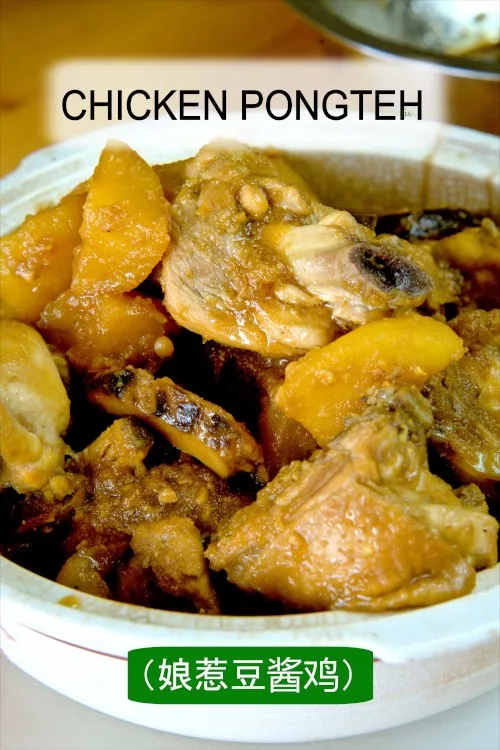
2. How to cook Ayam Pongteh
Here are the step-by-step instructions for preparing Chicken Pongteh (Ayam Pongteh).
a. Deep-fry the potatoes
To prepare the potatoes, peel and cut them into one-inch pieces. If you do not cook them right away, submerge them in water to prevent them from changing color due to oxidization.
Once the potatoes are cut, drain them in a colander and wipe them with a dry cloth. This will prevent them from splattering during the deep-frying.
Deep-frying the potatoes adds flavor and prevents them from breaking down during stewing. However, if you do not like fried food, you can stew the raw potatoes and chicken together without deep-frying them.
To deep fry the potatoes, heat oil in a wok and fry them until they develop a light char at the edges and a golden brown color. Once done, remove them from the oil and place them on a paper towel to absorb the excess oil.
b. Saute the shallot, garlic, and seasonings
Peel the shallots and garlic and chop them roughly. Then, blend them in a food processor until they form a paste. You don’t need to add water to blend since the shallots contain enough water. Also, it is not necessary to blend them until they disintegrate entirely. Traditionally, a mortar and pestle are used to pound them roughly instead of using a food processor.
Next, remove most of the oil from the wok used to fry the potatoes in the previous step. Leave two to three tablespoons of oil in the wok and add the blended shallot and garlic paste. Saute them over medium heat until the color turns slightly darker and releases an aromatic flavor.
Add the light soy sauce, fermented yellow soybean paste, dark soy sauce, and water.
c. Add the chicken and mushrooms
Add chicken pieces, Chinese mushrooms, and potatoes to the wok. You may want to do a taste test to add some salt according to your taste. I also added two tablespoons of palm sugar to one kilogram of chicken to give it a slightly sweet but savory flavor, which is the authentic taste of Chicken Pongteh.
Note: Soak the dried shiitake mushrooms in water until soft, remove stems, and cut into slices before use.
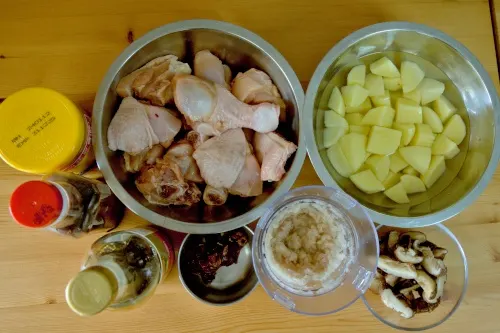
d. Stew until the chicken becomes tender
Cook the chicken and potatoes over low heat. At the 17-minute mark, I use a kitchen thermometer to check the doneness of the chicken. I stop cooking once the chicken is fully cooked, as overcooking can toughen the meat.
Once the chicken and potatoes are done, remove them from the wok and transfer them to a serving dish. For the best flavor, serve with sambal belacan.
Note: If you plan to serve the Chicken Pongteh immediately, you can marinate the chicken in light soy sauce for an hour before cooking. However, marinating may not be necessary if you intend to serve it later, as the flavor will penetrate the chicken and potatoes over time.
Another Baba Nyonya food related to Ayam Pongteh
If you like this Peranakan recipe, I have some related recipes called Chicken Kapitan that I want you to try. Its taste is distinct from other curries due to the addition of kaffir lime leaves and shrimp paste (belacan) during cooking.
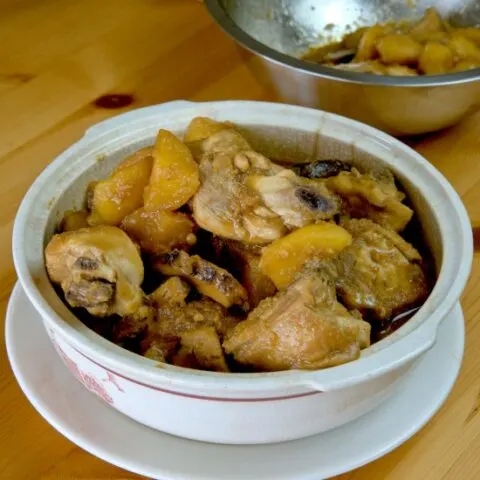
Ayam Pongteh- Baba and Nyonya chicken potato stew
Ayam Pongteh (Chicken Pongteh) is a chicken and potato stew with a unique blend of Malay and Chinese flavors.
Ingredients
- 100g shallots
- 8 cloves of Garlic
- 3 tbsp of fermented bean paste (Taucu)
- 1kg chicken thighs, bone-in, skin-on chunks
- 2 tbsp light soy sauce
- 2 tbsp dark soy sauce
- 1 cup of water
- 450g potatoes, cut into large chunks
- 5 medium-sized dried shitake mushrooms (soak and cut into slices)
- 2 tbsp palm Sugar (Gula Melaka)
- 1/4 tsp salt
Instructions
- Peel and cut the potatoes into one-inch chunks. Drain them in a colander and wipe them with a dry cloth.
- Heat oil in a wok and fry the potatoes until they are slightly charred at the edges and a light golden brown. Once done, place them on a paper towel to absorb the excess oil.
- Peel the shallots and garlic and chop them roughly. Then, blend them in a food processor until they form a paste.
- Soak the dried shiitake mushrooms in water until soft, remove stems, and cut into slices before use.
- Saute the blended shallot and garlic paste with oil over medium heat until the color turns slightly darker and releases an aromatic flavor.
- Add the light soy sauce, fermented yellow soybean paste, dark soy sauce, and water.
- Add the chicken pieces, mushrooms, and potatoes to the wok. Add salt and palm sugar.
- Cook the chicken and potatoes over low heat. Once the chicken is fully cooked, stop cooking it, as overcooking can toughen the meat.
- Remove them from the wok and transfer them to a serving dish.
Recommended Products
As an Amazon Associate and member of other affiliate programs, I earn from qualifying purchases.
Nutrition Information:
Yield: 4 Serving Size: 1Amount Per Serving: Calories: 736Total Fat: 35gSaturated Fat: 11gTrans Fat: 0gUnsaturated Fat: 25gCholesterol: 320mgSodium: 1617mgCarbohydrates: 45gFiber: 6gSugar: 15gProtein: 65g
This data was provided and calculated by Nutritionix on 3/18/2024

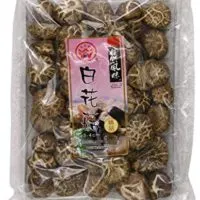
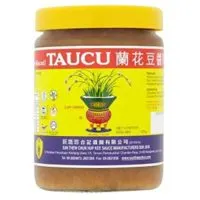
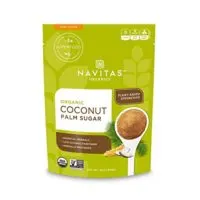
KP Kwan
Tuesday 19th of March 2024
Hi, this is KP Kwan. Thank you for reading my recipe. Please feel free to ask any questions or leave comments. I’ll respond as soon as possible.